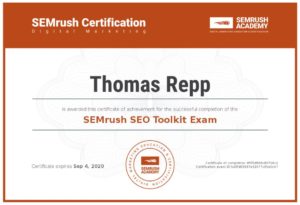 Great question … right?
Great question … right?
As a savvy industrial marketer, this question haunts you every day because you know that brand identity now depends on online visibility and the best way to gain online visibility is to be at the top of the search engine return pages (SERP) for all of your search terms or topics related to your industrial business.
Well, here is the answer...
KNOWLEDGE, HARD WORK and PATIENCE!
Now, in today’s short-cut world, I know what you are thinking, “Maybe I can use artificial intelligence as a short cut to top rankings for my company.” True, you can use elements of AI to help.
For example, many of today’s online tools use AI to make your marketing more productive. Google’s new Google Analytics 4 (GA4) uses AI to identify opportunities that would be difficult to uncover manually. Many of these insights can help you identify your buyer’s behavior, making it easier to create the content that will attract the most traffic and therefore leads. However, as I explained in my last blog post GA4 can be a real time drain!
As I also explained in my last blog post, many of your best marketing automation platforms, such as HubSpot, also use AI to improve their analytics and reporting. Much of this magic happens in the background where you do not even notice, making the industrial marketers’ job easier.
To prove my point that it takes a ton of work to get to the top, I posed a specific question to ChatGPT , currently the most popular AI tool.
“How do I get my mid-size B2B industrial company to the top of Google's search engine return page?”
Below, in rust, is the exact answer I received in about 15 seconds.
Unbelievable!
Months before artificial intelligence splashed onto the world’s consciousness, I published an ebook titled, Do Your Brand & Sales Materials Greet Your Buyer on the 1st Page of Google. My ebook outlined 11 steps to achieve top position for your industrial company. The general outline of my ebook and ChatGPT’s outline are almost identical. FYI, the ebook I created took a couple of months to research, write, proof, etc. Not to mention the 15 years of experience bundled into this 30-page ebook. Of course, my ebook provides much more context, detail and case stuides than ChatGPT's 15 second outline.
If you do not care read ChatGPT’s 10-step process below, allow me to summarize:
ChatGPT’s outline below recommends using online research tools such as SEMrush, which I also recommend in my ebook and use daily. In fact, the topic of this article you are currently reading was recommended by one of SEMrush's new AI features. Based on AI, SEMrush told me this topic (i.e. How do get my industrial B2B company to the top of Google?) had “high ranking potential". I will measure it and see.
A most notable exception to the ChatGPT's 10 step process was the omission of any discussion about industrial branding.
Industrial companies need to make sure their industrial company’s brand story is being well told before they invest time to create and publish online content for your brand’s visibility and ultimately lead generation. On the long road to content creation, this can be the real difference maker.
Back to the premise of this article, it still takes KNOWLEDGE, HARD WORK and PATIENCE to get to the top of Google.
So, without further ado, below is ChatGPT’s answer to the question I posed to ChatGPT:
“How do I get my mid-size B2B industrial company to the top of Google's search engine return page?”
The following answer or outline was provided in 15 seconds:
Getting your mid-size B2B industrial company to the top of Google's search engine results page (SERP) requires a combination of strategic optimization techniques and consistent effort. Here are some steps you can take to improve your company's search engine rankings:
- Keyword Research: Identify the relevant keywords and phrases that potential customers might use to find your products or services. Tools like Google Keyword Planner, SEMrush, or Moz Keyword Explorer can assist you in finding valuable keywords.
- On-Page Optimization: Optimize your website's on-page elements to align with your target keywords. This includes optimizing title tags, meta descriptions, headers, and incorporating keywords naturally within your website's content.
- Quality Content: Create high-quality, informative, and relevant content that addresses the needs and interests of your target audience. This will attract visitors and help establish your company as an authority in your industry. Consider maintaining a blog, publishing whitepapers, case studies, or creating educational videos.
- Link Building: Build high-quality backlinks from reputable websites in your industry. You can achieve this through guest blogging, participating in industry forums, reaching out to influencers or thought leaders for collaborations, or creating shareable content that naturally attracts links.
- Local SEO: If your company operates within a specific geographic region, ensure that your website is optimized for local search. This involves creating and optimizing a Google My Business profile, obtaining online reviews, and ensuring consistent NAP (Name, Address, Phone) information across online directories.
- Mobile Optimization: As mobile usage continues to rise, having a mobile-friendly website is crucial. Optimize your website for mobile devices to enhance user experience and improve your search rankings.
- User Experience: Focus on creating a user-friendly website that is easy to navigate, loads quickly, and provides a seamless browsing experience. Google considers user experience as an important ranking factor.
- Technical SEO: Ensure your website is free from technical issues that could hinder search engine crawling and indexing. This includes optimizing site speed, fixing broken links, improving site structure, and implementing schema markup to enhance search visibility.
- Social Media Presence: Establish an active presence on relevant social media platforms. Share your content, engage with your audience, and promote your company's products or services. Social signals can indirectly impact your search rankings.
- Analytics and Monitoring: Use tools like Google Analytics and Google Search Console to monitor your website's performance, track keyword rankings, and identify areas for improvement. Regularly review your SEO strategies and make adjustments as necessary.
Remember that achieving top rankings on Google's SERP is a long-term effort and requires consistent optimization, content creation, and monitoring. It's important to stay up-to-date with SEO trends and adapt your strategies accordingly. Consider consulting with SEO professionals if you need specialized expertise or guidance.
So, ChatGPT clearly knows what it is talking about and rendered a pretty darn accurate outline.
I also used Google’s version of AI called Google Bard with similar results with an obvious bias towards Google’s advertising platforms. Google's AI response included the following:
"In addition to these tips, you can also consider using paid search advertising to help you get to the top of Google's search results. Paid search advertising allows you to show your ads to people who are already searching for products or services like yours." No surprise here. This is a great example of how AI is largely dependent the coder's bias.
It still takes KNOWLEDGE, HARD WORK and PATIENCE
And … as Open AI (ChatbotGPT), Google Bard and yours truly recommends, grab some outside help to get your B2B industrial to the top of Google so your brand can dominate your industrial niche.
Author:Tom Repp
A passionate marketer attempting to change the way industrial marketers leverage the web as a growth-oriented, lead generation machine. View all posts by Tom Repp




